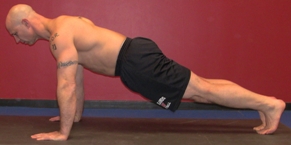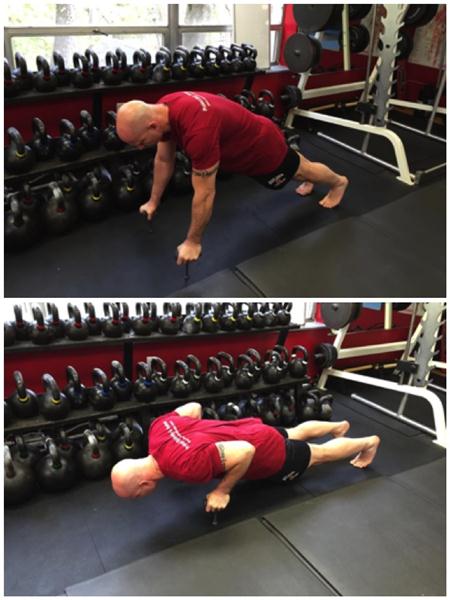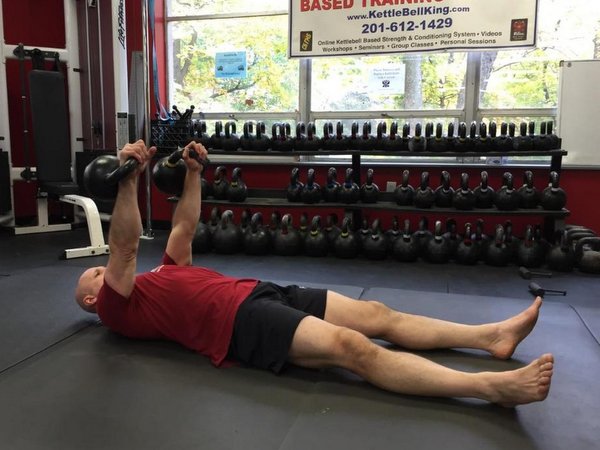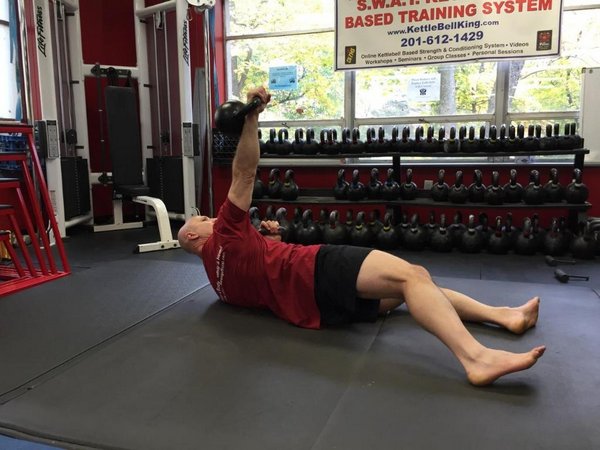Kettlebells Are Cool, But What About My CHEST?
By Phil Ross, Master RKC
"What about my chest?"
I've heard this question on more than one occasion from newbies in my class and just in casual conversation. This question usually comes from people with a bodybuilding or powerlifting background. These guys are used to working individual body parts and have their obligatory leg, chest, back and arm days. They might utilize the push-pull principle or another version of a split routine.
Depending upon your goals, these workouts may suit your needs. But if you are looking for an incredible, full-body workout to do just three to four times a week, then the answer is kettlebell and
bodyweight training. On the off days, engage in restorative training and other physical activities of your choice. Personally, I do a great deal of stretching, Martial Arts (striking and grappling), and roadwork (short distance and sprints).
One of the greatest advantages of using kettlebells and bodyweight exercises for chest development is that you’re also working your core, lats and stabilizers at the same time. You aren’t lying on a bench or tethered to a machine trying to isolate your muscles while leaving your core and stabilizers virtually untapped. Obviously, if you are a powerlifter you will still need the bench press—and bodybuilders will need to achieve symmetry with some isolation training. Although, I've seen quite a few people achieve great builds and incredible strength with only bodyweight and
kettlebells, I do not know of any bodybuilding champions who only train with bodyweight and kettlebell exercises.
While I’m sitting here writing this blog, my chest is screaming from yesterday's workout! I led my class through a five round, ten exercise circuit. For every set, we did 50 seconds of work and 10 seconds of rest. The three chest concentration exercises that we used were
push-ups, dips and plyometric push-ups. For four of the five sets of push-ups, I used the Neuro-Grip push-up tools, and one set of decline scorpion push-ups. The plyometric push-up variations included hands off the mat, hands and feet off of the mat, offset, skewed and superman versions (hands and feet off the mat with limbs extended). For the dips, I keep my feet forward and my chin down, which changes the focus to the inner and lower pecs while taking a lot of stress off of the shoulders and triceps.

There is a virtually unlimited list of fun push-up variations—I perform over 30 variations on a regular basis. Please note that you should perform push-ups with your "elbow pits" facing forward. Also, make the negative phase active by "pulling" yourself down while including your lats in the movement. It's also important to "tighten your butt and tighten your gut" while maintaining a solid plank position throughout the movement.
Some of my favorite push-up variations use equipment. If I use two kettlebells, I place them at a slight inward angle. Other kettlebell push-up variations include bottoms-up with two hands on one kettlebell, or with one kettlebell in each hand. A set of parallette bars are a lot of fun, and will allow you to get nice and deep. Medicine ball push-up variations include both hands on, one hand on and alternating the ball from side to side. If you have a set of gymnastic rings,
they can be used for very challenging push-up adaptations. You may have your feet on the ground or you can raise your feet to various heights. Last but certainly not least, there’s the
Neuro-Grip push-up handles. They are my absolute favorite. Not only are your pecs left begging for mercy, but your grip, core and stabilizers are dramatically challenged.

If you are unable to perform a standard push-up, then practice them with your hands placed on an elevated surface like a wall, counter top, step or bench. Once you can do the standard (or RKC) push-ups, we can move onto the other variations like knuckle, offset (one hand to the side and one close to the chest), skewed (one hand by the body and the other out in front), spiderman, scorpion, decline, archer, one arm (and the many variations thereof), one arm one leg, 10 and 5 second versions (10 or 5 second count up and down), extended, triangle, reverse, wide, palm heel, scapular, fingertip (5, 3, 2 or 1 fingers), back of the wrist, around the clock, multi-position, tiger, dive bombers, handstand (on a wall or free standing, more shoulder focus than pecs), one arm pumps and reverse.
Want to add another explosive level of power development? Then try
plyometrics. Developed by the Russian scientist, Yuri Verkhoshansky, plyometrics were used to increase the performance of track and field athletes by "shocking" the muscles of the legs and core during landing, then repeatedly exploding upward.
Now, on to the kettlebells!Most of the chest exercises that I teach have us lying on our backs with either one or two kettlebells in hand. The floor (or flat) press, alternating floor press, single kettlebell floor press, bottoms-up floor press and chest crushers are some of movements we practice on a regular basis.

Double Kettlebell Floor (Flat) Press
Lie flat on your back, then place one kettlebell in each hand. I used to grab both kettlebells, place them between my legs, and then rock backward with them. That worked until I started using
40kg and above. A few years ago, Senior RKC Robert Miller showed me a technique that I use to this day: roll one kettlebell into position and use your leg to slide the other one into your free hand. This great technique enables you to get two heavy bells into each hand by yourself.
Floor Press, Double or Single Kettlebell
When performing a floor press, make sure your elbows touch the mat before you begin the ascent of the next repetition. During the press, rotate the kettlebells by about ¼ turn so that your thumbs point toward your head at the bottom of the movement, and toward each other level with your chest at the top—just like throwing a punch. Your arms should be held tightly to your body at the bottom and the handles should be only one to two inches apart at the top. This technique will accentuate the activation of your pecs. With double kettlebells, we generally perform about 10 reps at a time. For the single kettlebell version, we usually go very heavy and perform sets of 5 reps.

Alternating Floor (Flat) Press
Bring both kettlebells into position as you would for the double kettlebell floor press. Keep your legs straight, but slightly bend them and drive from your heels if necessary. Shift from one side, simultaneously lowering one kettlebell while pressing the other as you shift from side to side. Usually, we'll perform 8 to 10 reps on each side.
Bottoms-Up Floor (Flat) Press
This should only be done with one kettlebell at a time. It is not recommended or a safe practice to attempt this move with two kettlebells. Rack the kettlebell while lying on the floor, then place it in the bottoms-up position. Again, make sure that your elbow touches the mat at the start of the movement, and that you press the kettlebell until your elbow is in full lockout. The rep range is 5 to 10—lower reps for power, and higher if we are working on muscular endurance.
Chest Crushers
Chest crushers can be practiced while standing or in a bent-over row position (knees bent). In either position, keep your spine is neutral. Keep your fingers off of the kettlebell and make sure that you don't "cup" your hands. Instead, your palms should be flat against the kettlebell as you "crush" it with your chest while fully extending your arms. Press the kettlebell to completion, then bring it back to your chest on the way back. This movement is done slowly—three to five seconds on the way out and the same speed on way back to your chest. Perform 5 to 10 reps per set, depending on the weight of the kettlebell and the duration of the movement.
There you have it! These are my favorite chest building exercises for kettlebells and bodyweight. I do some other chest exercises with sledgehammers and dynamic tension as well, but that's for another blog! Enjoy!
Strength and Honor!
Coach Phil
Back